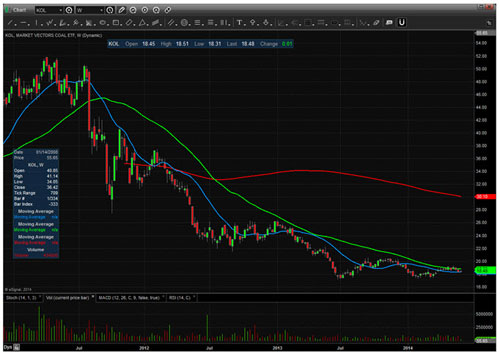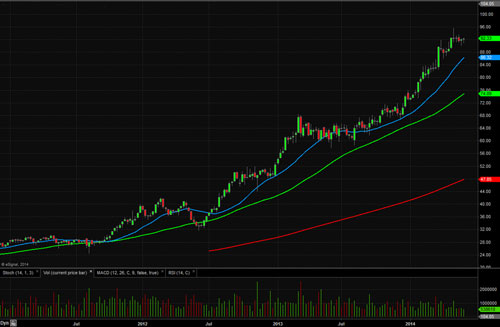|
MARKET ROUNDUP
|
Sometimes a picture tells a thousand words. And boy do the next two charts speak volumes.
The first shows the performance of the Market Vectors Coal ETF (KOL), an exchange traded fund that tracks the performance of 35 leading coal producers in the U.S., China, Australia, Canada and other countries. You can see that it has plunged from the low-$50s three years ago into the high teens today, a decline of around 65 percent.
|
“The coal industry is dying on the vine, courtesy of federal pressure, while gas is increasingly seen as the wave of the future.” |
At the same time, here’s a chart of one of my favorite plays in the natural gas and gas liquids transportation and storage business. (Hint: It’s in the Safe Money model portfolio, where it’s spinning off big profits. You can learn more about it — and get my “buy” and “sell” signals here — or by calling 800-291-8545).
You can see this gas-levered stock has done nothing but rally for the past three years. It recently hit an all-time high of around $95, more than tripling its value since this time in 2011.
What the heck is going on? How can two investments in the energy and materials sector perform so differently? I believe it’s because the coal industry is dying on the vine, courtesy of federal pressure, while gas is increasingly seen as the wave of the future.
Look, we all know coal is a dirty fuel when it comes to power generation. Burning it spews off tons of greenhouse gases, and the federal government has taken aim at those emissions.
The Environmental Protection Agency (EPA) just proposed new regulations designed to slash carbon dioxide emissions by 30 percent from a 2005 baseline by 2030. To meet those tough standards, utilities realize they need to increasingly turn away from coal as a fuel source.
That’s because older, inefficient, and dirty coal-based plants are a primary reason why power plants produce an estimated 38 percent of the country’s carbon-based pollutants. The cars and trucks we drive are next in line at 32 percent.
It’s also where natural gas comes in. Gas-driven plants produce roughly half the carbon emissions of coal-based units. Many of them are newer and more efficient than their coal-based counterparts.
It also doesn’t hurt that the U.S. is swimming in relatively cheap, abundant natural gas due to all the new finds we’re uncovering, fracking technology, and more. Domestic production surged to 24.3 trillion cubic feet last year. That was up more than 20 percent from five years ago and the highest level ever, according to the Energy Information Administration.
The way I see it, we’re in the midst of a secular shift here — away from coal and toward gas. As part of that, we’re also shifting away from imports of coal, oil, and gas, and toward domestic production and/or more aggressive exports. That is creating all kinds of winners … but also some losers. The key is being able to separate the two.
So what do you think? Is the U.S. better off with a gas-based and electric utility industry? Or are there hidden downsides to weaning our nation off of coal? What will the impact of this shift be on jobs, the economy, and the stock market? Have you profited from specific energy recommendations, and what are your favorites for the coming few quarters? Hop over to the blog to share.
| OUR READERS SPEAK |
We have quite a lively debate going on over the 1-percent crowd, and income inequality in America in general. Some strongly believe we’ve lost our way as a nation, with a virtual corporate kleptocracy led by executives who “skim all they can” the new norm. Others said we should celebrate success and let productive, hard-working people spend their money how they want.
Reader Jerry F. is a fan of the progressive politician and regulator Elizabeth Warren, author of “A Fighting Chance.” He calls it a “good thorough study of the causes of the wealthy getting it all, at the expense of the middle class … Her passion to protect the average American could propel her to the White House.”
Likewise, Reader Marilyn G. reacted angrily to the stories of opulence and conspicuous consumption. She said:
“I find this astonishing. I mean, disgusting! While so many families are struggling to put food on the table, find a decent place to live. To say nothing of the unemployed with no unemployment benefits left. Reminiscent of France before the Revolution. “No bread? Then let them eat cake!”
But Reader Carl B. had a different take. His view? “Seems much of the anger about the 1 percent is connected to how they spend their money. Imagine they spent most of their money on inner city schools or children with cancer instead of on yachts or penthouses. I think this is envy, pure and simple. These men are working within the system and being rewarded for their contributions.”
If you want to add your voice to the discussion, I’d love to hear your view. Just go to the blog and weigh in.
| OTHER DEVELOPMENTS OF THE DAY |
 Mega-bank BNP Paribas of France is reportedly facing some stiff penalties, including at least $8 billion in fines and the ouster of some top-level executives.
The French government is up in arms, protesting the move to U.S. officials. Me? I want to know why U.S. banks and U.S. bankers never got smacked down like this for the U.S. mortgage and credit market meltdown. Could it be because all the U.S. regulators want cushy jobs on Wall Street when their terms expire? No, perish the thought!
 Looks like the Federal Reserve is getting nervous about plunging volatility too. Ironic, considering the Fed itself caused it. I’ll have more on this topic later in the week, but here’s an important Wall Street Journal story on the topic you should not miss!
 Russian President Vladimir Putin threw a wrench in the works during President Barack Obama’s European tour. He offered to meet for face-to-face talks, an offer that followed Obama’s meeting with Ukraine President-Elect Petro Poroshenko. That prompted a slight, intraday move lower in crude oil and volatility.
 Yesterday, I told you about what $110 million will get you in downtown Manhattan if you’re at the top of the income spectrum. Today, I stumbled across this brief item showing what $1,200 a month gets you in another wildly expensive city, London.
Yikes! I guess the only “benefit” is that instead of just eating breakfast in bed, you can do your dishes in bed, too.
Reminder: If you have any thoughts to share on these market events, all you have to do is hop on over to the blog and leave your comments.
Until next time,
Mike Larson
 Â The waiting game ahead of tomorrow’s ECB policy meeting and Friday’s jobs report continued today, with stocks modestly higher on light volume. The S&P 500 rose 3.6 points, while the Nasdaq Composite gained 17.6. Ten-year Treasury yields, metals, and energy commodities were essentially unchanged.
 The waiting game ahead of tomorrow’s ECB policy meeting and Friday’s jobs report continued today, with stocks modestly higher on light volume. The S&P 500 rose 3.6 points, while the Nasdaq Composite gained 17.6. Ten-year Treasury yields, metals, and energy commodities were essentially unchanged.


